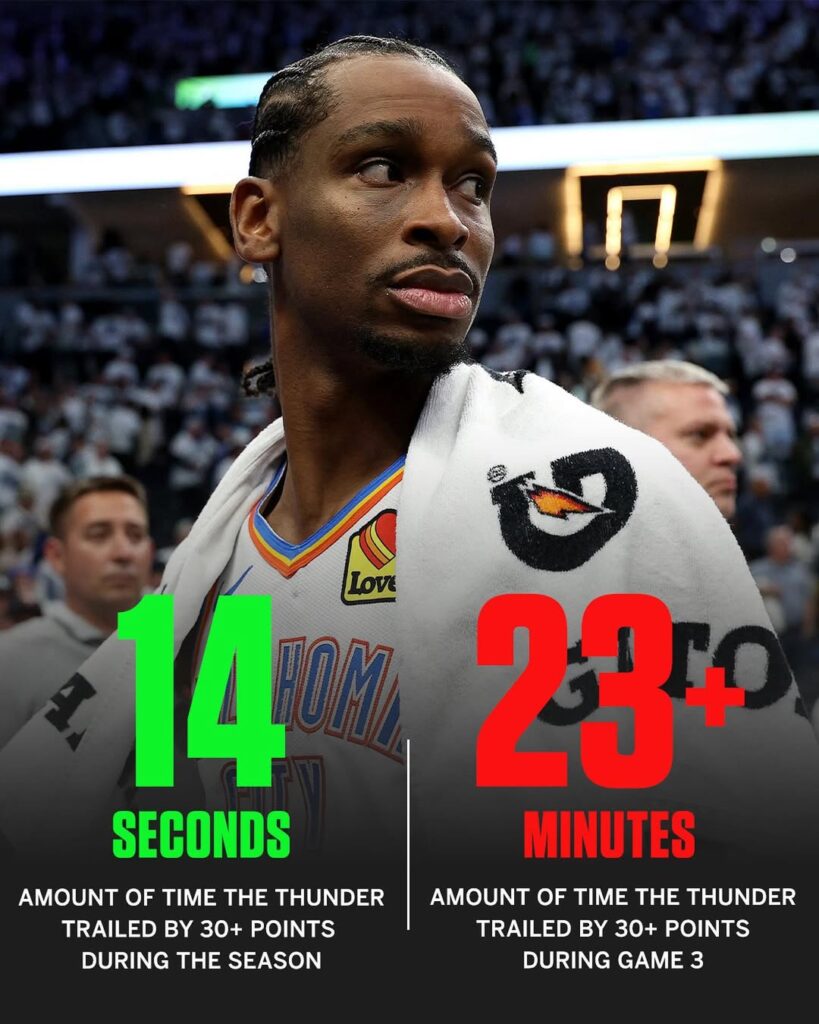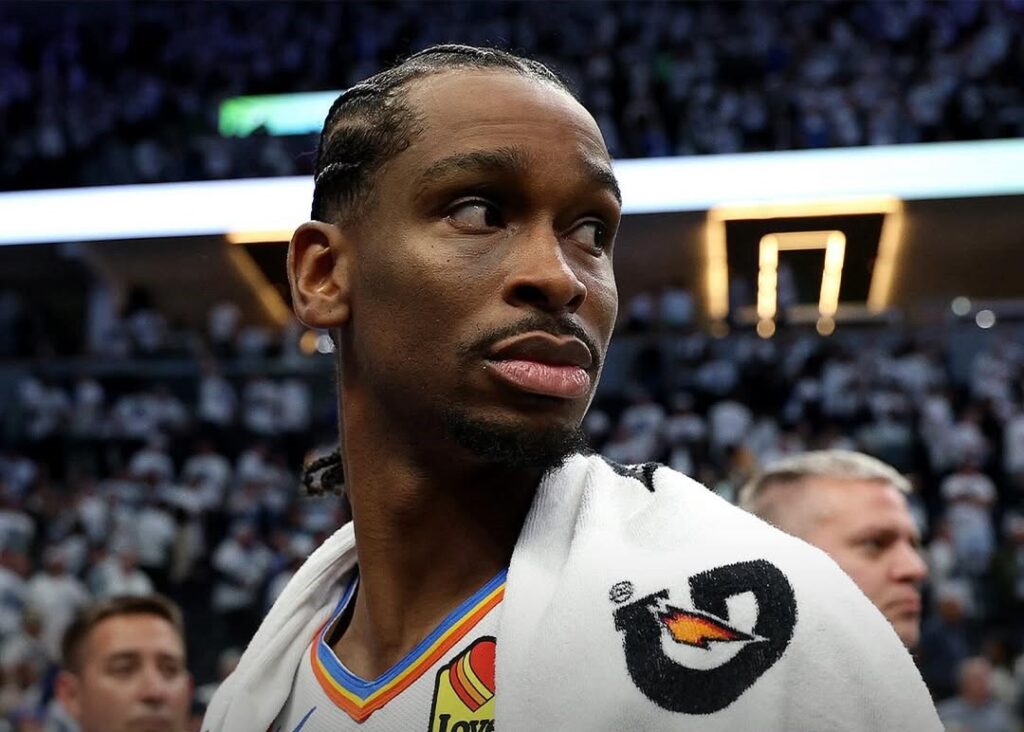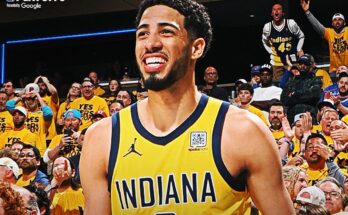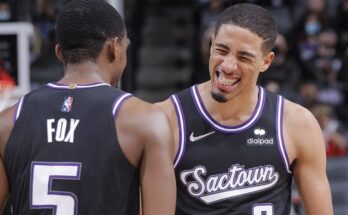
Let that sink in.
A team that had taken the NBA world by storm, led by a rising superstar and supported by one of the most balanced rosters in the league, suddenly looked… mortal. Shook. Even—dare we say—outclassed.
That’s not hyperbole. That’s math.
In Game 3 of the Western Conference Finals, the Oklahoma City Thunder spent more minutes trailing by 30 or more points than they had in the entire regular season and playoffs combined up to that point. It’s a mind-bending stat that seems almost impossible—until you watched the game unfold.
The Collapse: Live and Unfiltered
From the opening tip, something felt off. The Thunder—usually calm, poised, and explosive—came out flat. Not “just missing shots” flat. No, this was something deeper: poor rotations, terrible spacing, no rim protection, and a level of confusion that could be seen on every player’s face.
The other team? They smelled blood in the water and pounced like apex predators. Every mistake Oklahoma City made was punished—ruthlessly. Transition threes. Backdoor cuts. Offensive rebounds. It felt like the Thunder were trying to sprint through molasses, while their opponents had rocket fuel in their veins.
By the end of the first half, the scoreboard read like a typo: 73-39.
A 34-point deficit.
Let’s say that again: the Thunder, a team known for fighting tooth and nail every game, was down 34 at halftime.
It got worse before it got better.
The Numbers Don’t Lie (Unfortunately)
According to Second Spectrum and Synergy data, the Thunder had only trailed by 30+ points for a combined 8 minutes all season before Game 3—including both regular season and playoffs.
In Game 3 alone? 19 minutes and 43 seconds.
That means over double the total amount of “down by 30” time they had accumulated all year happened in a single game. On the national stage. In the Conference Finals.
😳 indeed.
It was the kind of collapse that makes you question everything. Was this team really ready for the moment? Was the youth showing? Was the coaching staff outmaneuvered? Did the lights get too bright?
What Went Wrong?

It wasn’t one thing. It was everything.
- Shai Gilgeous-Alexander, the steady hand and engine of the team, looked rushed and uncomfortable. He couldn’t get downhill, couldn’t find his midrange rhythm, and the defensive pressure swallowed him whole.
- Jalen Williams and Chet Holmgren, both instrumental to the team’s fluid offensive movement, were neutralized early. Holmgren in particular looked overwhelmed by the physicality, swarmed in the paint like a toothpick among tree trunks.
- The bench—normally a strength—provided no spark. No comeback energy. No run-stopping moments.
- And defensively? It was a disaster. Late switches. Slow closeouts. No communication. At times, it looked like a scrimmage more than a playoff game.
Credit Where It’s Due
It’s easy to dunk on the Thunder after a game like this, but part of the story is what the other team did right.
They came in hungry, focused, and surgical. Every set they ran felt purposeful. Every defensive possession looked like it had been studied and rehearsed a thousand times. Their stars showed up. Their role players stepped up. Their energy was off the charts.
Game 3 wasn’t just an Oklahoma City failure—it was a masterclass by their opponent.
Youth Under Pressure
It’s worth remembering: the Thunder are young.
Like, really young.
Holmgren is a rookie. Jalen Williams is in his second year. Even Shai, despite his All-NBA status, is only 25 and still getting his first real taste of deep playoff basketball as the guy. They’ve been ahead of schedule all season, outpacing expectations and playing with maturity beyond their years.
But Game 3? That was the wake-up call. The moment where youth met pressure, and pressure punched first.
It doesn’t mean they’re frauds. It means they’re learning.
Painfully. Publicly.
Now What?
The question now is simple: how do they respond?
Because championship teams aren’t defined by how they dominate when things are going right—they’re defined by how they recover when everything goes wrong. And Game 3? Everything went wrong.
If they fold in Game 4, the narrative shifts. The optimism starts to fade. The whispers begin: “Were they ever really ready?” But if they punch back—if they regroup, reset, and fight—then this blowout becomes a footnote in a much larger story of resilience.
Perspective Matters
Let’s zoom out.
The Thunder weren’t even expected to make the Western Conference Finals a year ago. Now, they’re here. They’ve won big games. They’ve earned respect. And yes, they got humbled in historic fashion in Game 3—but sometimes, a slap to the face is what you need to wake up.
Every great team has a moment like this. The Heat in 2011. The Warriors in 2016. The Celtics last year. Growing pains don’t always look like slow progress. Sometimes they look like a train wreck on national TV.
But it’s how you fix the wreckage that counts.
Conclusion
So yeah, the Thunder spent more time down by 30 in one night than they had all year. That’s shocking. Embarrassing, even.
But it’s also a challenge.
Because greatness isn’t built in blowouts. It’s built in the comeback.
Let’s see what they do next.



